
FlexBond®PremiumCrackPreventionThinsetMortar/TDS115
1 Product Name
FlexBond®PremiumCrackPreventionThinsetMortar
2 Manufacturer
Custom Building Products
Technical Services
10400 Pioneer Boulevard, Unit 3
Santa Fe Springs, CA 90670
Customer Support: 800-272-8786
Technical Services: 800-282-8786
Fax: 800- 200-7765
Email: [email protected]
custombuildingproducts.com
3 Product Description
A premium quality, polymer-modified mortar with exceptional flexibility
and bond strength for tiling difficult surfaces, such as plywood, vinyl
and laminates, and for hard-to-bond, nonporous tile, such as porcelain
and glass.
Key Features
High flexibility to prevent cracks in tile
Excellent bond strengths
Outstanding bond to glass and other decorative tile
Suitable Tile Types
Vitreous, semi-vitreous and absorptive tile: ceramic, mosaic, quarry,
cement body tile
Impervious glass and porcelain tile
Natural stone
Cement-based precast terrazzo
Brick
Thin brick
Suitable Substrates
Concrete, mortar beds, masonry, Portland cement plaster
WonderBoard® Lite cement backerboard
Liquid applied waterproofing membranes such
as RedGard® and Custom® 9240
Crack prevention sheet membranes such as Crack Buster® Pro
Uncoupling membranes such as RedGard®UncouplingMat
Surfaces treated with MBP Multi-Surface Bonding Primer
Exterior Grade Plywood (interior residential and light commercial dry
areas)
Gypsum wallboard (interior dry areas)
Existing ceramic tile (scarified)
Fully-bonded sheet vinyl flooring (scarified)
Plastic laminates (scarified)
Cutback adhesive (see preparation instructions)
Composition of Product
FlexBond®CrackPreventionMortarisadry,proprietaryblendof
Portland cement, copolymers, inorganic aggregates and chemicals
Benefits of Product in the Installation
Outstanding flexibility and bond strength for difficult substrate and tile
applications
Protects against cracking caused by minor in-plane surface movement
Isolates small cracks and can be applied over small cracks without
additional preparation
Exceeds ANSI A118.4, A118.15 and A118.11 standards without the
need for additives
Approved for industry-recommended interior and exterior applications
Limitations to the Product
Do not bond directly to hardwood, Luan plywood, particle board,
parquet, cushion or sponge-back vinyl flooring, fiberglass, plastic or
OSB panels.
When setting moisture sensitive natural stone, cement or agglomerate
tile use EBMLite™EpoxyBondingMortar100%Solids or CEGLite™
100% Solids Commercial Epoxy Grout.
Do not use to install resin-backed stone; use EBMLite™EpoxyBonding
Mortar 100% Solids, CEGLite™100%SolidsCommercialEpoxy
GroutorcontactCustom's®TechnicalServicesforrecommendations.
For clear or translucent glass, CUSTOM recommends Glass Tile
Premium Thin-Set Mortar. When setting glass tile larger than 6" x 6"
(15x15cm),contactCustom's®TechnicalServicesfor
recommendations.
When setting dimensional stone larger than 12" x 12" (30 x 30 cm),
contactCustom's®TechnicalServicesforrecommendationsregarding
subfloor deflection requirements.
Contact CUSTOM Technical Services when installing metal tiles
Packaging
50 lb (22.68 kg) and 25 lb (11.34 kg) bags
Gray or white
4 Technical Data
Applicable Standards
AmericanNationalStandardsInstitute(ANSI)—ANSIA108.5,A118.4,
A118.15 and A118.11 of the American National Standards for the
Installation of Ceramic Tile ASTM International (ASTM)
FlexBond®PremiumCrackPreventionThinsetMortar
Published Date: 3/27/2018

FlexBond®PremiumCrackPreventionThinsetMortar/TDS115
ASTM C109 Standard Test Method for Compressive Strength of
Hydraulic Cement Mortars (Using 2-in or [50-mm] Cube Specimens)
ASTM C627 Standard Test Method for Evaluating Ceramic Floor Tile
Installation Systems Using the Robinson-Type Floor Tester
Resilient Floor Covering Institute - (RFCI) Recommended Work
Practices for Removal of Resilient Floor Coverings
Tile Council of North America (TCNA) - TCNA Handbook for Ceramic
Tile Installation, TCNA Method EJ171
ISO 13007-2
Technical Chart
Property Test Method Requirement Typical Results
Pot Life 4 Hours
Open
Time (E)
A118.15
Section 5.3
E = 30
Minutes
Pass
4 Week Shear Bond Strength
Glazed
Wall Tile
A118.15
Section 7.1.2
> 450 psi 600 - 700 psi
(42.249.2kg/cm²)
Porcelain
Tile
A118.15
Section 7.2.5
> 400 psi 400 - 500 psi
(28.135.2kg/cm²)
Quarry
Tile to
Plywood
A118.11
Section 4.1.2
> 150 psi 300 - 350 psi
(21.124.6kg/cm²)
Environmental Consideration
Custom®BuildingProductsiscommittedtoenvironmental
responsibility in both products produced and in manufacturing
practices.UseofthisproductcancontributetowardsLEED®v3
certification:
Up to 2 points towards MR Credit 5, Regional Materials
Up to 2 points towards MR Credit 4, Recycled Content
Upto1pointtowardsIEQCredit4.1,LowEmittingMaterials–
Adhesives & Sealants
5 Instructions
General Surface Prep
USE CHEMICAL-RESISTANT GLOVES, such as nitrile, when
handling product.
Surfaces must be structurally sound. Remove all grease, oil, dirt,
curing compounds, sealers, adhesives or any other contaminant that
would prevent a good bond. Glossy or painted surfaces must be
sanded, or abraded, and stripped of all contaminants. Concrete must
be cured 28 days and accept water penetration. Concrete must be free
of efflorescence and not subject to hydrostatic pressure. Concrete
slabs should have a coarse finish to enhance the bond. Plywood
flooring including those under resilient flooring must be structurally
sound and meet all ANSI and deflection requirements. For questions
about proper subfloor installation, call Technical Services. Smooth
concrete surfaces, existing glazed tile, terrazzo, or polished stone
should be scarified. Sheet vinyl must be well bonded and stripped of
old finish. Roughen the surface by sanding or abrading, then rinse and
allow to dry. Expansion joints should never be bridged with setting
material. Do not sand flooring materials containing asbestos. Ambient
temperatureshouldbemaintainedabove50°F(10°C)orbelow100°
F(38°C)for72hourstoachieveproperbond.
Bonding to Concrete Surfaces
Concrete or plaster must be fully cured and must accept water
penetration. Test by sprinkling water on various areas of the substrate.
If water penetrates, then a good bond can be achieved; if water
beads, surface contaminants are present, and loss of adhesion may
occur. Contaminants should be mechanically removed before
installation. Concrete must be free of efflorescence and not subject to
hydrostatic pressure. Concrete slabs should have a coarse finish to
enhance the bond. Smooth concrete slabs must be mechanically
abraded to achieve proper bond.
Bonding to Lightweight Cement and Gypsum Surfaces
Lightweight or gypsum based underlayments must obtain a minimum
2000 psi (13.8 MP) compressive strength. The underlayment must be
sufficientlydryandproperlycuredtothemanufacturer’sspecifications
for permanent, non-moisture permeable coverings. Surfaces to be
tiled must be structurally sound and subject to deflection not to exceed
the current ANSI Standards. Surfaces shall be free of all grease, oil,
dirt, dust, curing compounds, waxes, sealers, efflorescence, or any
other foreign matter.
All Lightweight cement or Gypsum surfaces should be primed with a
properly applied sealer or a primer coat of RedGard, consisting of 1
part RedGard diluted with 4 parts clean, cool water. Mix in a clean
bucket at low speed to obtain a lump free solution. The primer can be
brushed, rolled or sprayed to achieve an even coat. Apply the primer
coat to the floor at a rate of 300 sq. ft.l (7.5 sq. m/L). Drying time
depends on site conditions, but is normally less than 1 hour. Extremely
porous surfaces may require 2 coats. At this point, RedGard can be
applied to the primed lightweight or gypsum based surface. Refer to
the individual product data sheet or packaging directions for application
instructions. Expansion joints must be installed in accordance with local
building codes and ANSI/TCNA guidelines. Refer to TCNA EJ171.
Bonding to Plywood Surfaces
Plywood floors, including those under resilient flooring, must be
structurally sound and must meet all ANSI A108.01 Part 3.4
requirements. Maximum allowable deflection: L/360 tile L/720 stone.
See TCNA F150-13 Tile Installations, TCNA F141-13 and F250-13 for
Stone. For questions about proper subfloor installation requirements,
call Custom technical services.
Bonding to Backerboards
As an alternative to an additional layer of plywood, WonderBoard
backerboard may be installed over plywood subfloors for ceramic tile
installations. Refer to TCNA F144-13 tile installations, TCNA F250-13
stone installations. Call Custom technical services when installing
natural stone over plywood subfloor.
Bonding to Existing Surfacing Material
Existing Ceramic Tile, Resilient Flooring or Plastic Laminates: Resilient
flooring or plastic laminates must be well bonded, as well as clean and
free of all contaminates. Roughen the surface by sanding or scarifying;
rinse and allow to dry. Do not sand flooring that contains asbestos. For
existing well bonded ceramic tile, mechanically abrade the surface.
Rinse and allow to dry. When sanding, an approved respirator should
be used.
FlexBond®PremiumCrackPreventionThinsetMortar
Published Date: 3/27/2018

FlexBond®PremiumCrackPreventionThinsetMortar/TDS115
Bonding to Cutback Adhesive
Adhesive layers must be removed, as they reduce mortar bond
strength to cement surfaces. Use extreme caution; adhesives may
contain asbestos fibers. Do not sand or grind adhesive residue, as
harmful dust may result. Never use adhesive removers or solvents, as
they soften the adhesive and may cause it to penetrate into the
concrete. Adhesive residue must be wet scraped to the finished
surface of the concrete, leaving only the transparent staining from the
glue. To determine desirable results, do a test bond area before
starting. Refer to the RFCI Pamphlet, "Recommended Work Practices
for Removal of Resilient Floor Coverings" for further information.
Movement Joint Placement
Movement joints are required for perimeters and other changes of
plane in all installations. Expansion joints and cold joints, as described
in ANSI A108.01, should never be bridged with setting material. They
must be brought through the tile work and filled with an appropriate
elastomeric sealant, such as Custom's 100% Silicone. Contact
Custom's Technical Services for the proper treatment of control or saw
cut joints. Refer to TCNA EJ171, F125 & F125A.
Mixing Ratios
Mix 5 qts (4.73 L) clean water per 50 lb (22.68 kg) bag of mortar.
Mixing Procedures
Mixbyhandorusealow150–200rpmspeed1/2"(13mm)drillto
achieve a smooth, paste-like consistency. Let the mixture slake or
stand5–10minutes;stiragainanduse.Stiroccasionally,butdonot
add more water. When properly mixed, troweled ridges will stand
without slump.
Application of Product
Installation must conform to ANSI A108.5. Use a properly-sized notch
trowel to ensure proper coverage under tiles. Using the flat side of the
trowel, apply a skim coat of mortar to the surface. With the notch side
ofthetrowelheldata45°angle,applyadditionalmortartothe
surface, combing in one direction. Press the tile firmly into place in a
perpendicular motion across ridges, moving back and forth. The
perpendicular motion flattens ridges and closes valleys, allowing
maximum coverage. With some tile, back-buttering is advisable. Adjust
the tile promptly and beat it in with a beating block and rubber mallet.
Mortar can be applied up to 1/4" (6 mm) thick after beat in. For thicker
applications, use a medium bed mortar; periodically pull up a tile and
check the back to ensure proper adhesive coverage. If the material has
skinned over (not sticky to the touch), recomb with the notch trowel; if
too dry, remove and replace the dry material with fresh material.
Curing of Product
Curing time is affected by ambient and surface temperatures and
humidity. Use the following as a guideline. Allow 24 hours before
grouting and light traffic. Allow 7-10 days before heavy or vehicular
traffic. Before exposure to heavy or vehicular traffic, assure assembly
israted“HeavyorExtraHeavy”perTCNAServiceRequirements.As
necessary, use plywood or other load distributing protection when
moving heavy equipment across tiled assembly. Submerged
installations must cure for 14 days before filling with water.
Cleaning of equipment
Clean with water before the material dries.
Storage
Store in a cool dry area.
Health Precautions
This product contains Portland cement and free silica. Avoid eye
contact or prolonged contact with skin. Wash thoroughly after
handling. If eye contact occurs, flush with water for 15 minutes and
consult a physician. Do not breathe dust; wear a NIOSH approved
respirator
Conformance to Building Codes
Installation must comply with the requirements of all applicable local,
state and federal code jurisdictions.
6 Availability & Cost
Location Item Code Size Color Package
USA FBG25 25 lb (11.34 kg) Gray Bag
USA FBW25 25 lb (11.34 kg) White Bag
USA FB50 50 lb (22.68 kg) Gray Bag
USA FBW50 50 lb (22.68 kg) White Bag
Canada CFB50 50 lb (22.68 kg) Gray Bag
7 Product Warranty
Obtain the applicable LIMITED PRODUCT WARRANTY at
www.custombuildingproducts.com/product-warranty or send a written
request to Custom Building Products, Inc., Five Concourse Parkway,
Atlanta, GA 30328, USA. Manufactured under the authority of Custom
BuildingProducts,Inc.©2017QuikreteInternational,Inc.
WhenFlexBond®CrackPreventionMortarisusedasapartofa
qualifying full installation system of CUSTOM products, the installation
can qualify for up to a lifetime system warranty. CUSTOM will repair
and/or replace, at its discretion, the affected area of the system. For
more information, find details and limitations to this warranty at
custombuildingproducts.com.
8 Product Maintenance
Properly installed product requires no special maintenance.
9 Technical Services Information
For technical assistance, contact Custom technical services at 800-282-
8786 or visit custombuildingproducts.com.
10 Filing System
Additional product information is available from the manufacturer upon
request.
Expected Wear
Properly installed tile will last for more than 60 years.
Related Products
Natural Stone & Large Tile Premium Mortar
FusionPro®SingleComponent®Grout
MegaLite®UltimateCrackPreventionLargeFormatTileMortar
FlexBond®PremiumCrackPreventionThinsetMortar
Published Date: 3/27/2018

FlexBond®PremiumCrackPreventionThinsetMortar/TDS115
Coverage
SQUARE FOOT COVERAGE PER 50 LB BAG (SQUARE METER PER 22.68 KG)
For tile with longest side 15"+, use a medium bed mortar from CUSTOM designed for large format and heavy tile.
Trowel Size Min Coverage Max Coverage
Longest side of tile less than 8" use 1/4" x 1/4" x 1/4" (6 x 6 x 6 mm) Square-Notch 85sq.ft.(7.9M²) 95sq.ft.(8.8M²)
Longest side of tile 8" to 15" use 1/4" x 3/8" x 1/4" (6 x 9.5 x 6 mm) Square-Notch 60sq.ft.(5.6M²) 67sq.ft.(6.2M²)
Recommended minimum coverage (80% for dry areas and 95% for wet areas and exteriors). Back buttering may be necessary.
Note that mortar coverage does not include backbuttering tiles. When backbuttering, consider the tile underside pattern and depth to estimate thickness
and usage to add to your estimate.
Chart for estimating purposes. Coverage may vary based on installation practices and jobsite conditions. For more sizes, use the material calculator at
CustomBuildingProducts.com or contact CUSTOM Technical Services at 800-282-8786.
FlexBond®PremiumCrackPreventionThinsetMortar
Published Date: 3/27/2018
-
 1
1
-
 2
2
-
 3
3
-
 4
4
Custom Building Products FBW50-20 Installation guide
- Type
- Installation guide
Ask a question and I''ll find the answer in the document
Finding information in a document is now easier with AI
Related papers
-
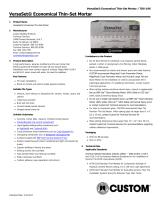 Custom Building Products VSW50 Installation guide
Custom Building Products VSW50 Installation guide
-
Custom Building Products TRMW1 Installation guide
-
 Custom Building Products PMG50 Installation guide
Custom Building Products PMG50 Installation guide
-
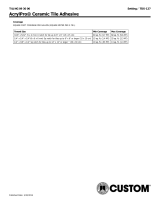 Custom Building Products ARL40003 Installation guide
Custom Building Products ARL40003 Installation guide
-
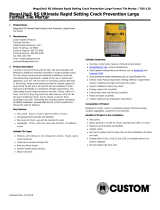 Custom Building Products MLRSG30 Installation guide
Custom Building Products MLRSG30 Installation guide
-
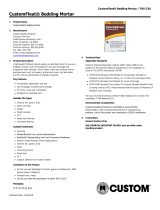 Custom Building Products CFT50 Installation guide
Custom Building Products CFT50 Installation guide
-
 Custom Building Products GTMW7-4 Operating instructions
Custom Building Products GTMW7-4 Operating instructions
-
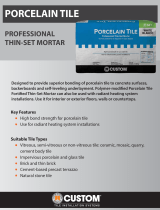 Custom Building Products PMW50 Specification
Custom Building Products PMW50 Specification
-
Custom Building Products FBG25 Installation guide
-
 Custom Building Products PLRSW30 Installation guide
Custom Building Products PLRSW30 Installation guide
Other documents
-
Lanco CP234-5 Installation guide
-
Lanco CB510-4 User manual
-
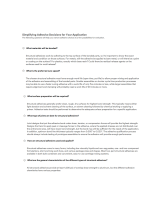 GBTRICON SG_B074DV1YRL_US User guide
GBTRICON SG_B074DV1YRL_US User guide
-
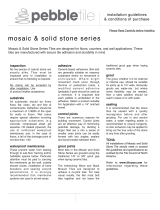 Cruz Bay xq3rwh Installation guide
Cruz Bay xq3rwh Installation guide
-
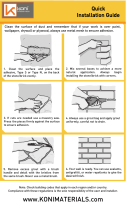 Koni Brick KBFT-252RSE Installation guide
Koni Brick KBFT-252RSE Installation guide
-
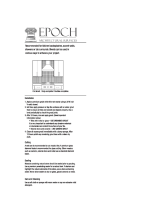 EPOCH CHIARRO SAMPLE Installation guide
EPOCH CHIARRO SAMPLE Installation guide
-
Jeffrey Court 94004 Installation guide
-
Jeffrey Court 13067 Installation guide
-
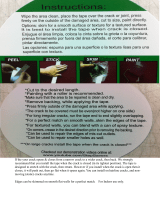 Stepsaver PRODUCTS 07050 Operating instructions
Stepsaver PRODUCTS 07050 Operating instructions
-
Unbranded RM916241P Installation guide
















